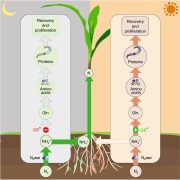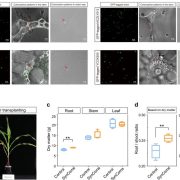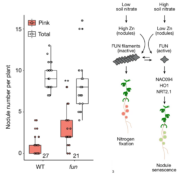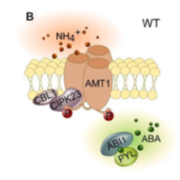Glutamine induces lateral root initiation, stress responses, and disease resistance in Arabidopsis
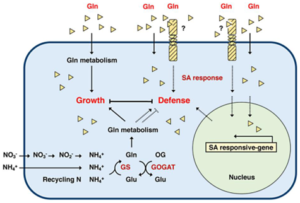 Nitrogen (N) is vital for plant growth, with plants typically absorbing inorganic N compounds like nitrate (NO3−) and ammonium (NH4+) from the soil. Yet plants can also utilize organic N sources, including amino acids like glutamine (Gln). Gln, as the first organic N compound assimilated within plant cells, goes beyond its metabolic function, influencing various aspects of plant biology. It regulates cytokinin biosynthesis, maintains salicylic acid (SA)-associated redox equilibrium, and plays roles in stress responses and pathogen defense, making it a key signaling molecule in plants. In a study conducted by Liao and colleagues, supplementing Gln as the sole nitrogen source not only stimulated plant growth and lateral root initiation, but also upregulated stress-responsive genes. Intriguingly, exogenous Gln primed the expression of defense genes, which in turn, reduced bacterial proliferation upon Pst DC3000 infection in Arabidopsis. Notably, this protective effect was abolished in the sid2 mutant and partially attenuated in the npr1 mutant, highlighting the reliance of Gln-mediated immune responses on the salicylic acid signaling pathway. This study sheds light on the dual nature of Gln, serving as both a metabolic derivative and a critical component in immune signaling pathways within Arabidopsis, which unveils the intricate interplay between nitrogen metabolism and plant defense mechanisms. (Summary by Ching Chan @ntnuchanlab) Plant Physiol. 10.1093/plphys/kiae144
Nitrogen (N) is vital for plant growth, with plants typically absorbing inorganic N compounds like nitrate (NO3−) and ammonium (NH4+) from the soil. Yet plants can also utilize organic N sources, including amino acids like glutamine (Gln). Gln, as the first organic N compound assimilated within plant cells, goes beyond its metabolic function, influencing various aspects of plant biology. It regulates cytokinin biosynthesis, maintains salicylic acid (SA)-associated redox equilibrium, and plays roles in stress responses and pathogen defense, making it a key signaling molecule in plants. In a study conducted by Liao and colleagues, supplementing Gln as the sole nitrogen source not only stimulated plant growth and lateral root initiation, but also upregulated stress-responsive genes. Intriguingly, exogenous Gln primed the expression of defense genes, which in turn, reduced bacterial proliferation upon Pst DC3000 infection in Arabidopsis. Notably, this protective effect was abolished in the sid2 mutant and partially attenuated in the npr1 mutant, highlighting the reliance of Gln-mediated immune responses on the salicylic acid signaling pathway. This study sheds light on the dual nature of Gln, serving as both a metabolic derivative and a critical component in immune signaling pathways within Arabidopsis, which unveils the intricate interplay between nitrogen metabolism and plant defense mechanisms. (Summary by Ching Chan @ntnuchanlab) Plant Physiol. 10.1093/plphys/kiae144


